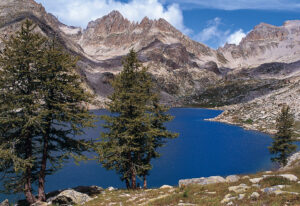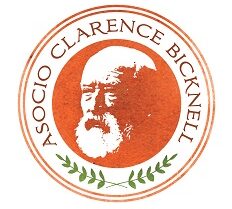 Clarence did not regard himself as an archaeologist. When he first went up into the Mercantour region in 1881, he certainly knew about the rock engravings but his main motive was to extend his botanical studies from the Mediterranean plants round Bordighera to include alpine specimens. He was to use the same painstaking and meticulous technique used in his botanical studies when he came to record the rock engravings.
Clarence did not regard himself as an archaeologist. When he first went up into the Mercantour region in 1881, he certainly knew about the rock engravings but his main motive was to extend his botanical studies from the Mediterranean plants round Bordighera to include alpine specimens. He was to use the same painstaking and meticulous technique used in his botanical studies when he came to record the rock engravings.
The area with the rock engravings now lies in the French national park Le Parc national du Mercantour little more than an hour’s drive directly north of Nice and Menton in the Alpes Maritimes. (Click here to see a Google map of the terrain around Casterino, Mont Bego and the Vallée des Merveilles) The 2872 metre Mont Bego is the most well-known (but not the highest) mountain, dominating the two main areas where the engravings have been found, the Vallée des Merveilles and the Val Fontanalbe.
The geological formation of the region is rare because the schists and sandstones are acidic whereas most of the Alpes Maritimes is calcareous and therefore alkaline. So not only are the plants different, but also the glacier-polished smooth surfaces of the acidic schists and sandstones must have been more tempting for prehistoric man to adorn with engravings. Furthermore, the general bleakness and wildness of these high valleys, and the ferocity of the afternoon thunder storms, provide a feeling of outside influences. Did those that make the engravings believe they were closer to their god? Certainly the nature of the place might have added further motivation to leave traces.

Snow prevented Clarence having any success on his first visit in 1881, but he returned in 1885 where he drew 50 engravings. Then followed a 12 year gap with Clarence busy in Bordighera opening the museum (1888) named after him, developing its activities and further travelling abroad, including Egypt. However, in 1897, he determined to explore the region more thoroughly by renting a house in Casterino. He had heard from the Italian Alpine Club that there were engravings in the Val Fontanable and this area was more easily accessible from Casterino, this small hamlet northwest of Tende. Here, and also in the Vallée des Merveilles, he first made 450 drawings, but realising this was not the most accurate method of making records, he then made 211 pencil rubbings. Photographs were also taken.
In 1898, he returned again to Casterino for 3 weeks, making 538 rubbings and taking more photographs. He also brought back two fragments of rock, with engravings on them, sending one off to the British Museum and keeping the other for his own museum. By the time of his death ten years later, he had recorded 12,718 engravings mostly from the Val Fontanalbe but also from the Vallée des Merveilles and Valauretta. He left these records to the University of Genoa, feeling that his own museum did not have adequate space or facilities to house this large collection.
Clarence divided the engravings into eight categories: horned figures, ploughs (image, right), weapons and tools, men, huts and properties, skins, geometrical forms and miscellaneous forms. His key insight was to recognise the images of ploughs and the oxen pulling them. Often these beasts, with their strange horns, do not look like oxen. But they must be, and they represent nearly a half of the total engravings. Clarence also noticed that some of the weapons looked like the halberds characteristic of the early Bronze Age and now these figures are dated by the actual metal physical objects found in archaeological deposits, and thus from the Copper Age to the early Bronze Age, about 2700 to 1700 BC. So they are over 3000 years old.
Clarence’s great contribution to the study of these engravings was concentrated in “A Guide to the Prehistoric Rock Engravings in the Italian Maritime Alps”, the final version of which was published in 1913. It was just that; an objective guide. He avoided the speculative conjectures of contemporaries such as Emile Cartailhac and Professor Arthur Issel and applied his botanist skills of systematic and accurate recording of all the engravings that he found. As he said himself, “We are only the collector of facts, and must leave to others the task of studying them more profoundly”.

Nonetheless, Clarence did, of course, allow himself to meditate on the significance of these engravings. He felt they were not just the work of bored shepherds. The area was too remote and too far and the huge number of engravings would have required much more time than a shepherd would have had the time to do while caring for his flock. So Clarence saw them as the result of pilgrimages: “It is not necessary to believe that there was anything especially sacred about the Monte Bego, or that a divinity had his seat there. Those coloured rocks were their archives, their Jerusalem or Mecca, and they went there to engrave something……..each one hoping to get some benefit in so doing”.
Subsequent studies continued in Clarence’s tradition. After Clarence’s death, Carlo Conti, the Italian sculptor, carried out a vast amount of work, laboriously making plaster casts of the figures. And in 1967, France’s eminent prehistorian, Henry de Lumley, started his work on this particular site with the collaboration of five research institutes. His first summary “Le Grandiose et le Sacré” was published in 1995. By then, the number of engravings had risen to over 37,000 figures and at the time was the largest record of prehistoric art ever made in Europe. This has now been superceded by the Valcamonica site situated in the Lombardy plain just two hours away from Mont Bego. One of the leaders of this 21st century dig is the same Christopher Chippindale of the Cambridge University Department of Archaeology and Anthropology who did so much, in the last quarter of the twentieth century with his papers in Antiquity and his book A High Way to Heaven, to attach value to Clarence Bicknell’s work. Valcamonica has provided one of the world’s greatest collections of prehistoric petroglyphs – more than 140,000 symbols and figures carved in the rock starting 8,000 years ago and then continuing over a period of 8,000 years, depicting themes connected with agriculture, navigation, war and magic.
More than 100 years after Clarence Bicknell’s unstinting work in the high mountains remains both a shining example of, and a significant contribution to, archaeology and our understanding of early man.
Susie Bicknell, April 2013
Bibliography
BICKNELL, CLARENCE. 1903. Further explorations in the regions of the prehistoric rock engravings in the Italian Maritime Alps. Bordighera: Pietro Gibelli.
already in list
BICKNELL, CLARENCE. 1904. Les inscriptions préhistoriques des environs de Tende, Annales de la Societé des Lettres, Sciences et Arts des Alpes Maritimes (1904):9–34.
BICKNELL, CLARENCE. 1904. Una gita primaverile in Sardegna, Bollettino della Società Botanica Italiana (1904):193–202.
BICKNELL, CLARENCE. 1906. Incisioni rupestri nuovamente osservate nelle alte valli delle Alpi Marittime, Atti della Società Ligustica di Scienze Naturali 17:8–22.
BICKNELL, CLARENCE. 1907. Una passeggiata botanica in Spagna, Bollettino della Società Botanica Italiana:74–7.
BICKNELL, CLARENCE. 1908. Nuovo contributo alla cognizione delle incisioni rupestri, Atti della Società Ligustica di Scienze Naturali 19:47–60.
BICKNELL, CLARENCE. 1909. La prahistoriaj gravurajoj sur rokoj en la Italaj Maralpoj, Internacia Scienca Revuo 6:161–70.
BICKNELL, CLARENCE. 1911. Dessins préhistoriques sur roches des Alpes Maritimes italiennes, Procès verbaux de la Societé d’Histoire Naturelle d’Autun 8.
BICKNELL, CLARENCE. 1911. Nouvelles découvertes de roches gravées dans les Alpes Maritimes, Revue Préhistorique 6:110–18.
BICKNELL, CLARENCE. 1911. The prehistoric rock engravings in the Italian Maritime Alps. 2nd edition. Bordighera: Pietro Gibelli.
already in list
BICKNELL, CLARENCE. 1913. A guide to the prehistoric rock-engravings in the Italian Maritime Alps. Bordighera: Giuseppe Bessone.
already in list
BICKNELL, CLARENCE. 1913. Incisioni rupestrei delle Alpi Marittime, Atti della Società Italiana per il Progresso delle Scienze, VI Riunione, Genova, Ottobre 1912. Roma.
BICKNELL, CLARENCE. 1971. Guida della incisioni rupestri preistoriche nelle Alpi Marittime italiane. Bordighera: Istituto Internazionale delle Studi Liguri. [Translation of the Guide of 1913.]
BICKNELL, CLARENCE. 1971. Guide des gravures rupestres préhistoriques dans les Alpes Maritimes. Bordighera: Institut Internationale d’Études Ligures. [Translation of the Guide of 1913.]
BICKNELL, CLARENCE. 2009. La flora di Bordighera, in Bordighera e dintorni:34–36. Seconda edizione – aggiornata. Con 14 illustrazioni e una cartina di Bordighera. Munich: A. Bruckmann. Guida illustrate Bruckmann n. 6. New edition of the 1900 guidebook with texts in both Italian and English.
PUBLICATIONS ABOUT CLARENCE BICKNELL
EVANS, ARTHUR. 1897. [Comment on C. Bicknell’s communication], Proceedings of the Society of Antiquaries 17:15–16.
ISSEL, A. 1902. Le nuove incisioni rupestre alpine illustrata da C. Bicknell, Bullettino di Paletnologia Italiana 28:234–47.
ISSEL, A. 1907. [Review of C. Bicknell, Incisioni rupestri nuovamente osservate nelle alte valli delle Alpi Marittime (1906)], Bullettino di Paletnologia Italiana (4th series) 3:181–2.
JULLIAN, C. N.D. [C. 1914]. [Review of C. Bicknell, A guide to the prehistoric rock-engravings in the Italian Maritime Alps (1913)], Revue des Études Anciennes.
Mostra delle incisioni rupestri delle Alpi Marittime, Museo Bicknell, Bordighera, 16 Aprile – 15 Giugno 1939. 1939. Alassio: Pozzi.
CHIPPINDALE, CHRISTOPHER. 1983. Il Legatò Bicknell: a report on the collection of material relating to the rock-engravings of Mont Bégo, Alpes-Maritimes, France, in the Istituto di Geologià, Università di Studi di Genova. Genova: Università di Studi di Genova, Istituto di Geologià.
CHIPPINDALE, CHRISTOPHER. 1984. Clarence Bicknell: archaeology and science in the 19th century, Antiquity 58:185–193.
CHIPPINDALE, CHRISTOPHER. 1985. ‘Una vita sacra’: Clarence Bicknell and the discovery of Alpine rock-engravings, in C. Malone & S. Stoddart (ed.), Papers in Italian archaeology 4. Oxford: BAR.
CHIPPINDALE, CHRISTOPHER. 1998. A high way to heaven: Clarence Bicknell and the “Vallée des Merveilles”. Tende (A-M): Conseil général des Alpes-Maritimes.
CHIPPINDALE, CHRISTOPHER. 1998. L’Échelle du Paradis: Clarence Bicknell et La Vallée des Merveilles. Tende (A-M): Conseil général des Alpes-Maritimes.
CHIPPINDALE, CHRISTOPHER. 1998. Le Scale del Paradiso: Clarence Bicknell e La Valle delle Meraviglie. Tende (A-M): Conseil général des Alpes-Maritimes.
CHIPPINDALE, CHRISTOPHER. 2003. La ‘Casa Fontanalba’: la vie de Clarence Bicknell, in Daniela Gandolfi & Mario Marcenaro (ed.), Clarence Bicknell: la vita e le opere: vita artistica e culturale nella Riviera di Ponente e nella Costa Azzurra tra Ottocento e Novocento (Rivista Ingauna e Intemelia 54–55):21–26. Bordighera: Istituto di Studi Liguri.
GANDOLFI, DANIELA & MARIO MARCENARO (ed.). 2003. Clarence Bicknell: la vita e le opere: vita artistica e culturale nella Riviera di Ponente e nella Costa Azzurra tra Ottocento e Novocento (Rivista Ingauna e Intemelia 54–55). Bordighera: Istituto di Studi Liguri.
Aileen Fox the archaeologist visited the Casa Fontanalba in 1927 and 1928. She left an interesting account of her experience in her autobiography Aileen – A Pioneering Archaeologist (Gracewing, Leominster UK, 2000). Read Graham Avery’s piece about Aileen’s account here
Una Vita Sacra: Clarence Bicknell and the Discovery of Alpine Prehistoric Rock Art is an early academic paper by Christopher Chippindale (Papers in Italian Archaeology 1985) and is available from http://www.barpublishing.com/. There is an excerpt here.
Christine Kulper argues that Bicknell’s work “could prove invaluable to connecting the dots of ancient civilizations”. Click on The Bicknell Petroglyph Engravings in the 21st Century 2017
Lire Faire « parler » les pierres: Le modèle naturaliste en archéologie préhistorique. Le cas de la Vallée des Merveilles, 1868-1913, papier de Maddalena CATALDI, Doctorante Centre Alexandre Koyré, EHESS, 2014-2016

